Is your favorite social network budding, fresh, ripe, or rotten?

Check Your Assumptions At The Door
In the 1990s, writing business books was easy. So was picking stocks. Remember day trading? It’s easy to pick stocks (or write business books) in a bull market. But nothing lasts forever, including bull markets, as history teaches us.
So when I sat down to analyze which social networks I should pay attention to and which I should ignore, I did so with the context of history as my guide. In the spring of 2012, the excellent article and infographic The Rise And Fall Of Online Empires: Will Facebook Survive? did the very same thing, comparing the rise (and sometimes fall) of six online companies: AOL, Yahoo!, AltaVista, MySpace, Digg, and Facebook. (And, yes, Facebook will survive.)
An embedded infographic from the 2012 article appears below. If the image fails to appear, then click the words “online empires infographic.” (Because the web-based Internet has only been around for 20 years and it’s not like anyone has had time to work on data standards or anything.)

Via: CenturyLinkQuote.com
I used those six companies as a starting point and added other top social networks to the list.
In the spirit of checking my assumptions at the door, here are mine. I assume that:
- Every company has a beginning, middle, and end.
- Google Trends is a good measure of a company’s beginning, middle, and end.
- Google Trends is a decent measure of a company’s beginning, middle, and end even if that company’s history pre-dates Google.
- Google Trends itself will be discontinued by Google, since Google has a long history of getting bored of (and then dropping) various products. See Wikipedia’s list of Google products (generally) and Google Reader (specifically, below).
- Google Trends cannot predict the future. (Otherwise I’d be a day trader.)
- A company has more or less peaked when it scores 100 on Google Trends.
- A company is more or less rotten when it scores 50 on Google Trends after having peaked.
Google Trends: Top 15 Social Networks
Without further ado, here are the top 15 social networking companies, as ranked by Google Trends, from most to least popular.
1. Facebook
2. YouTube
3. Google
4. Yahoo
5. MySpace
6. Twitter
7. blog
8. AOL
9. Tumblr
10. LinkedIn
11. Pinterest
12. AltaVista
13a. Google Plus
14. Digg
13b. Google+
15. Google Reader
13c. GooglePlus
Notes:
- I put Google on the list, because it is clearly an “online empire” although less clearly a social networking company.
- I put YouTube on the list because YouTube. And because this is one acquisition/brand that Google hasn’t broken/abandoned yet. (Note also that YouTube still isn’t profitable.)
- I but “blog” on the list because it is the broadest term that should include blogs, weblogs, blogger, Blogger, and blogging. Blogging is the only generic social network on this list.
- I put Google Plus on the list three times, since it’s the only one on the list with multiple common spellings of its name (i.e. Google Plus, Google+, and GooglePlus). Maybe social networking brands should be one word.
- Digg (perhaps an odd inclusion on the first list) is slightly below Google Plus in the rankings but can take some comfort in being slightly above Google+, Google Reader, and GooglePlus. (Note also that Digg Reader is still awesome, especially given the untimely death of Google Reader.)
From the results, you can clearly see the interest in various social networks rise and fall over time.
I’ve grouped the social networks into four stages:
- For budding social networks, the interest graph includes only the left side of the interest bell curve. No obvious peak is yet in sight for these social networks.
- For fresh social networks, the interest graph includes the middle of the bell curve. Perhaps these social networks have peaked, perhaps not.
- For ripe social networks, the interest graph includes the right side of the bell curve. These social reworks appear to have peaked.
- For rotten social networks, the interest graph includes the entire bell curve. These social networks have peaked and are in decline (if not dead).
Stage 1: Budding Social Networks
This is the shortest list: Pinterest.
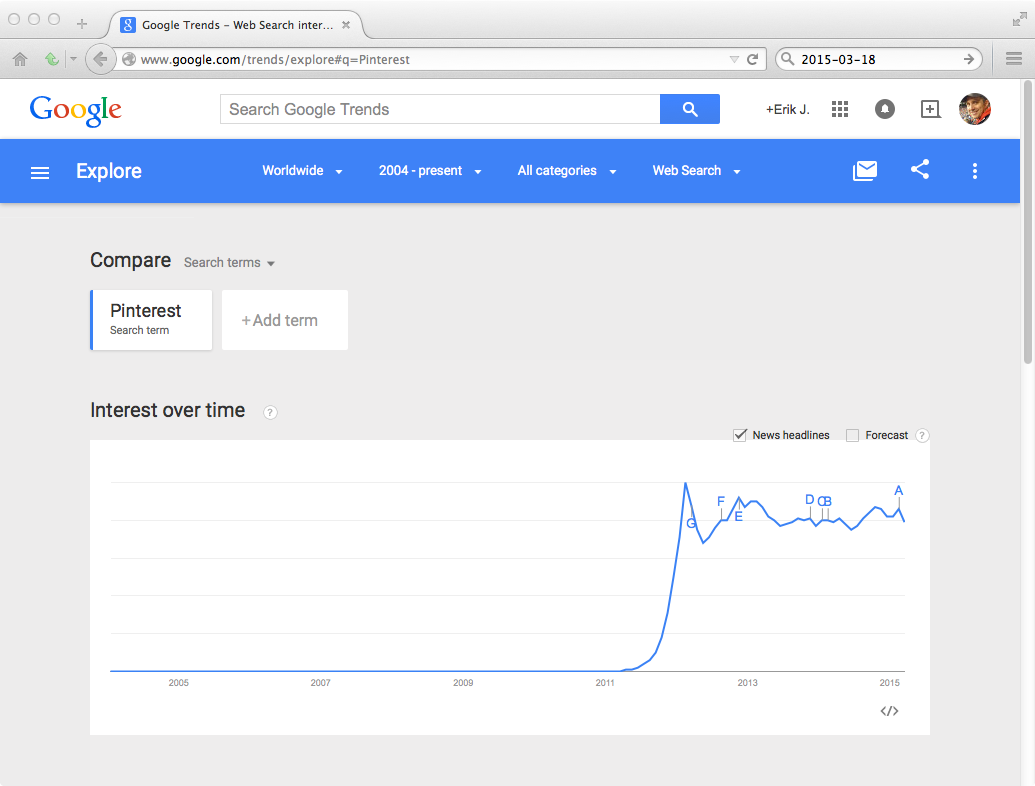
Pinterest (peak = February 2012, rotten = TBD)
Other top social networks Instagram and Vine could arguably be added to this list, but I had to draw the line somewhere.
Stage 2: Fresh Social Networks
Four social networks are fresh: YouTube, Google, Tumblr, and LinkedIn.
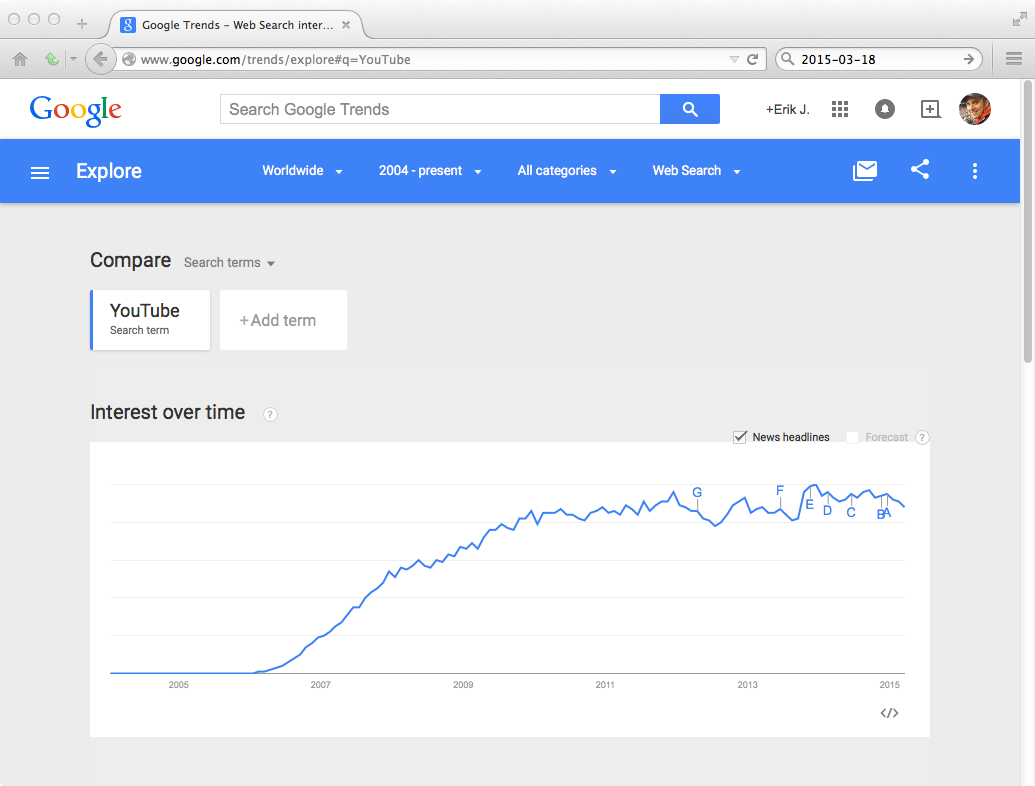
YouTube (peak = December 2013, rotten = TBD)
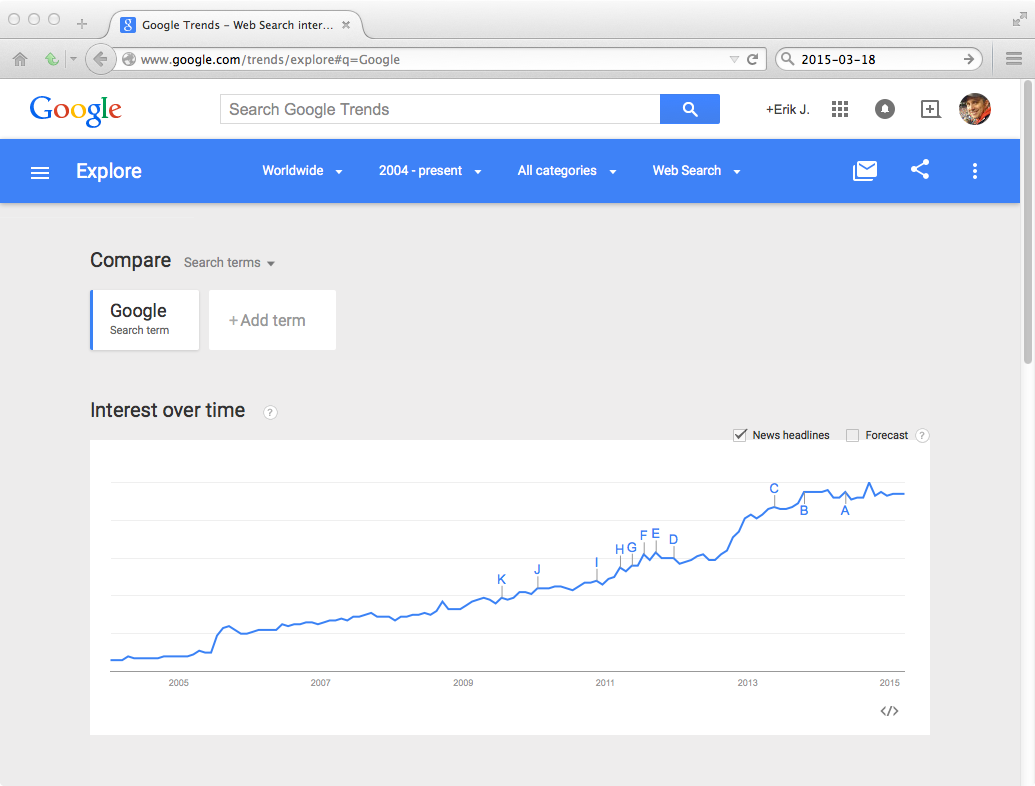
Google (peak = September 2014, rotten = TBD)
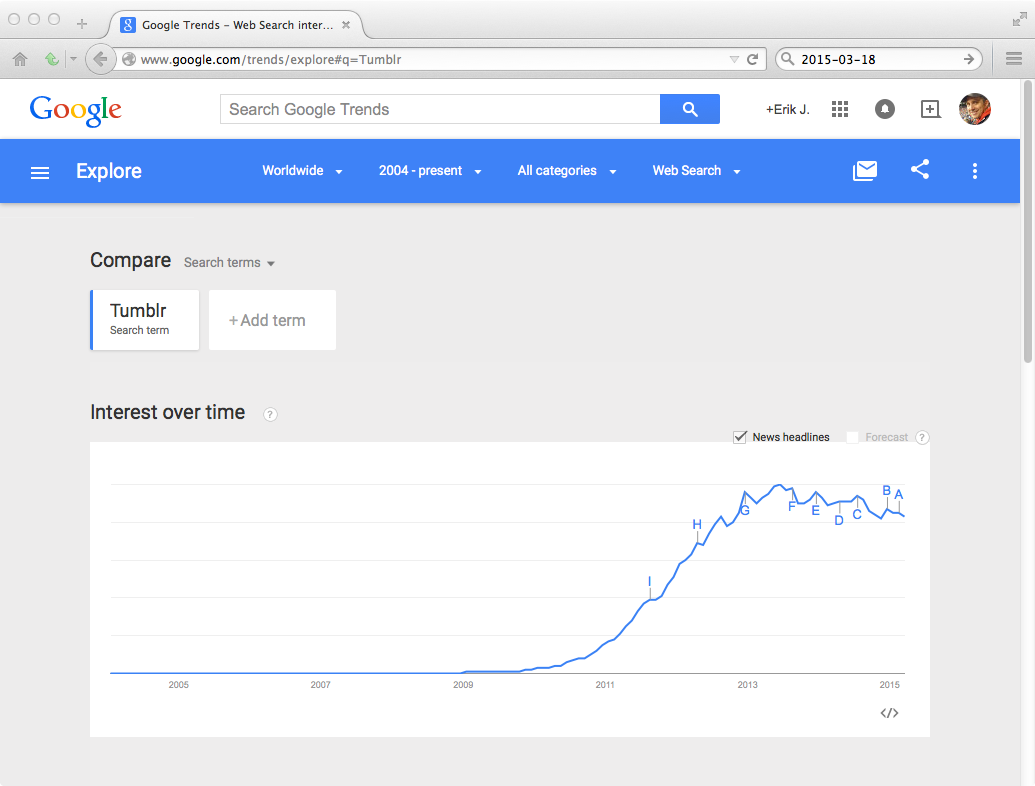
Tumblr (peak = June 2013, rotten = TBD)
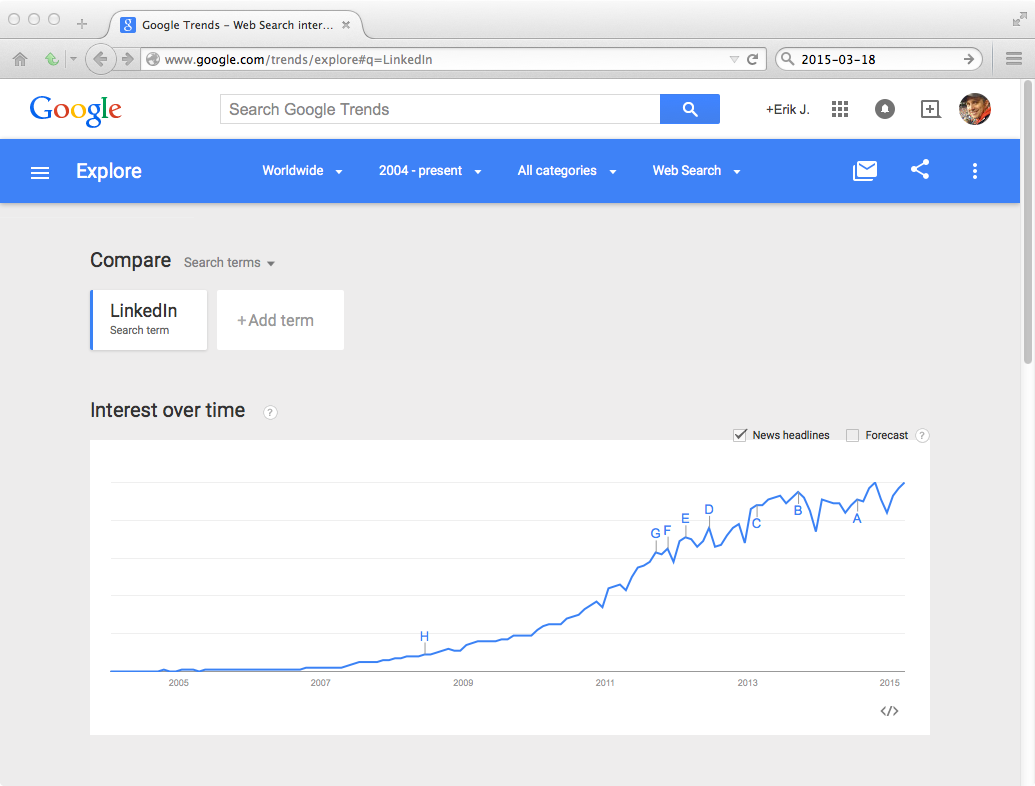
LinkedIn (peak = October 2014, rotten = TBD)
Stage 3: Ripe Social Networks
Three social networks are ripe: Facebook, Yahoo, and Twitter.
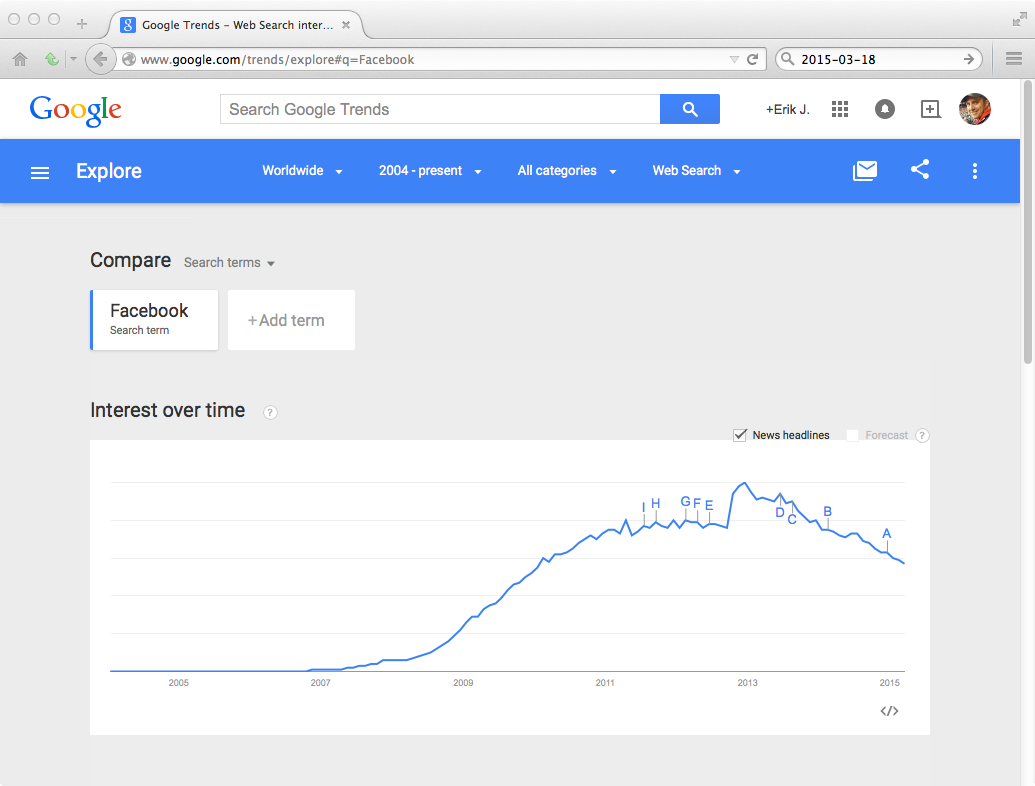
Facebook (peak = December 2012, rotten = TBD)
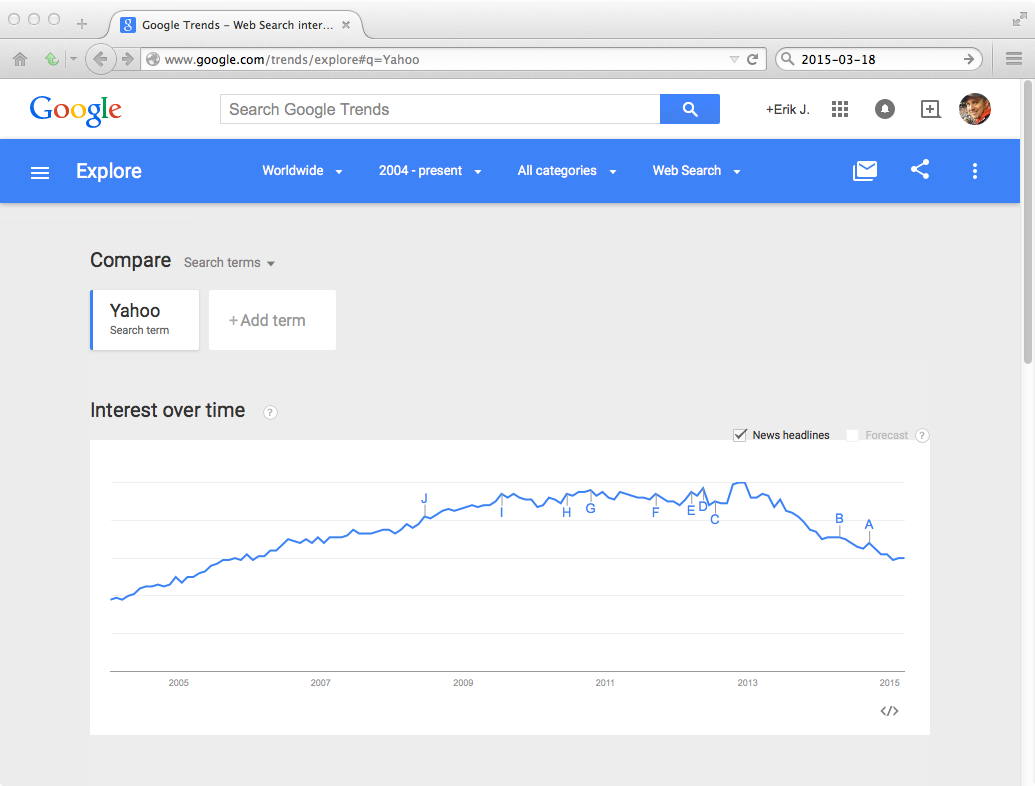
Yahoo (peak = November 2012, rotten = TBD)
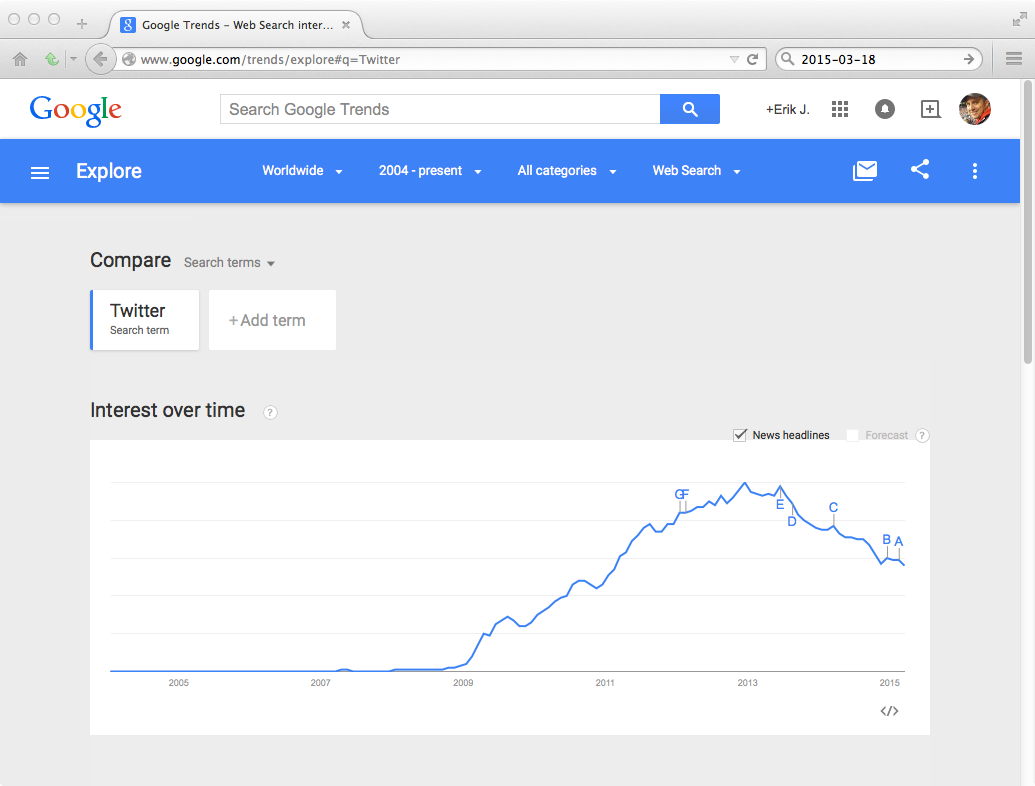
Twitter (peak = December 2012, rotten = TBD)
Stage 4: Rotten Social Networks
Seven social networks are rotten: MySpace, blog(ging), AOL, AltaVista, Digg, Google Plus (Google+, GooglePlus), and Google Reader.
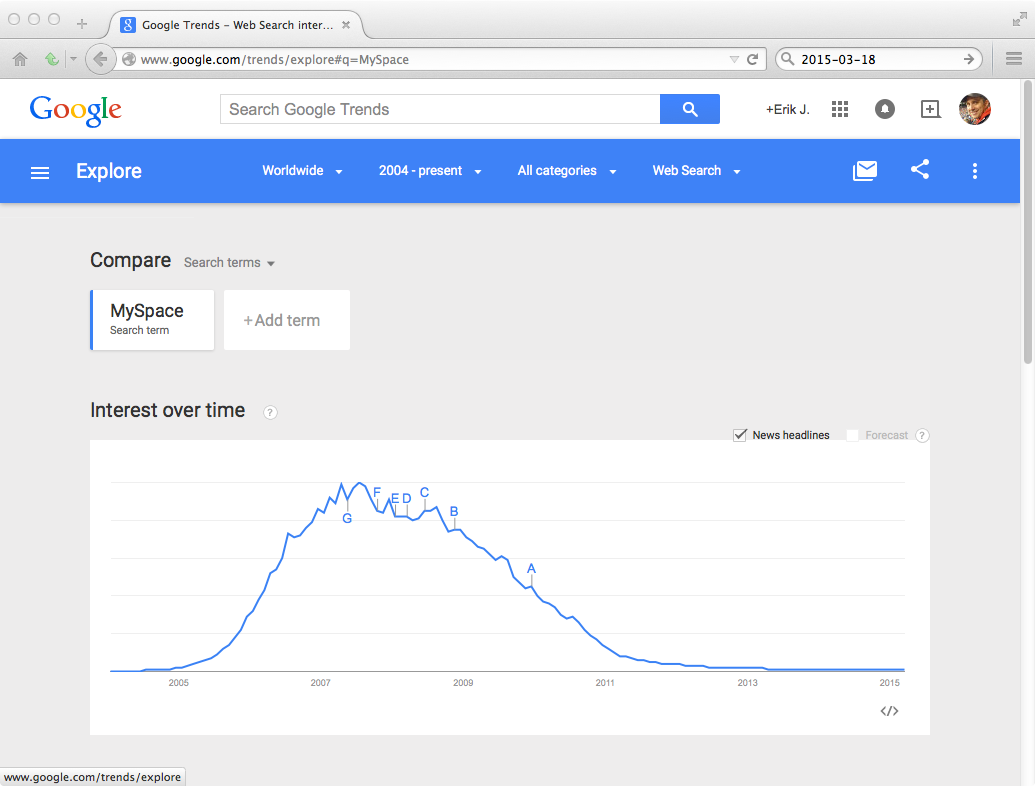
MySpace (peak = July 2007, rotten = September 2009)
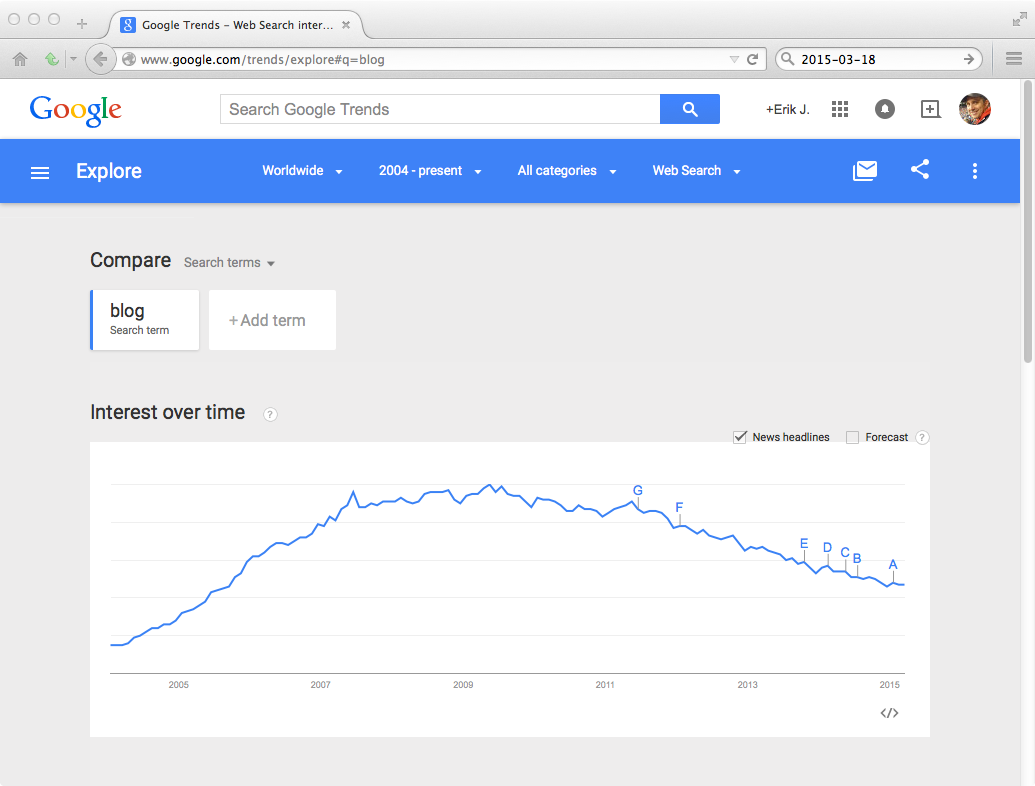
blog (peak = May 2009, rotten = August 2014)
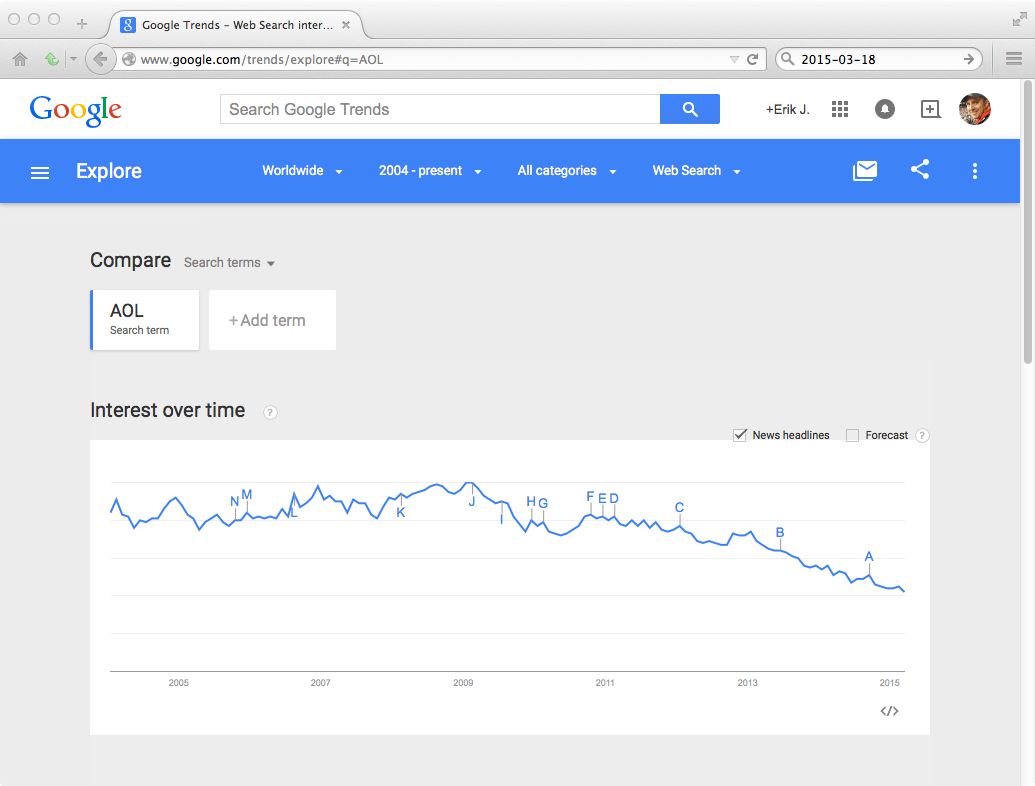
AOL (peak = January 2009, rotten = June 2014)
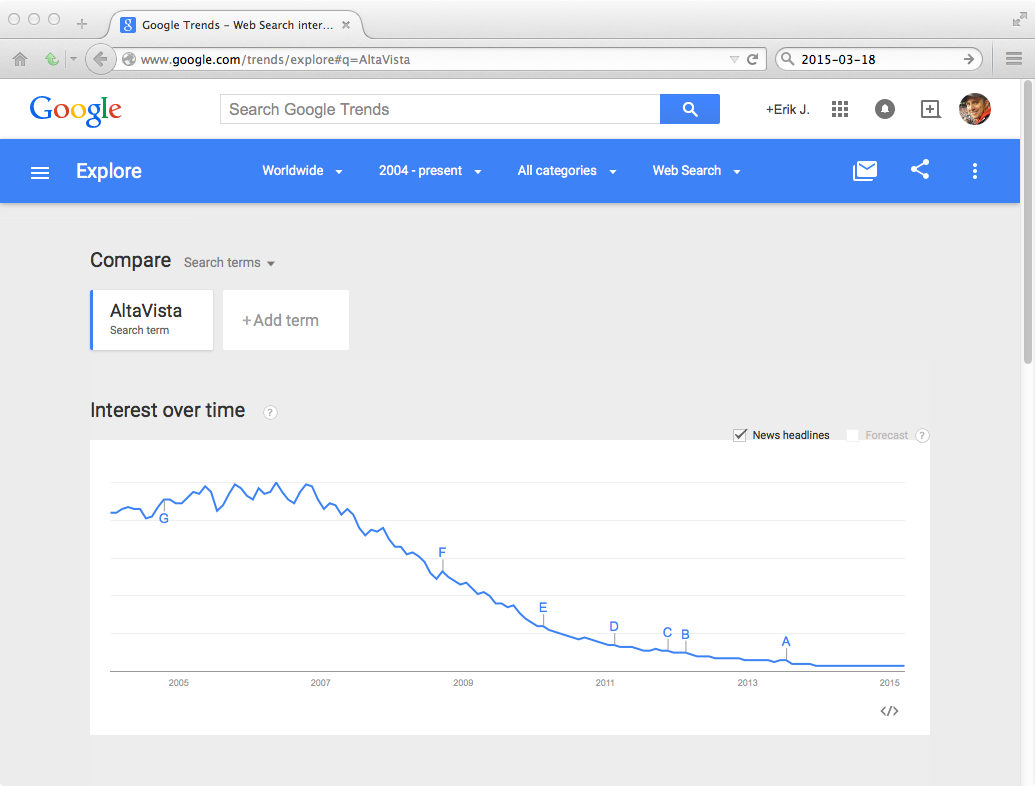
AltaVista (peak = May 2006, rotten = August 2008)
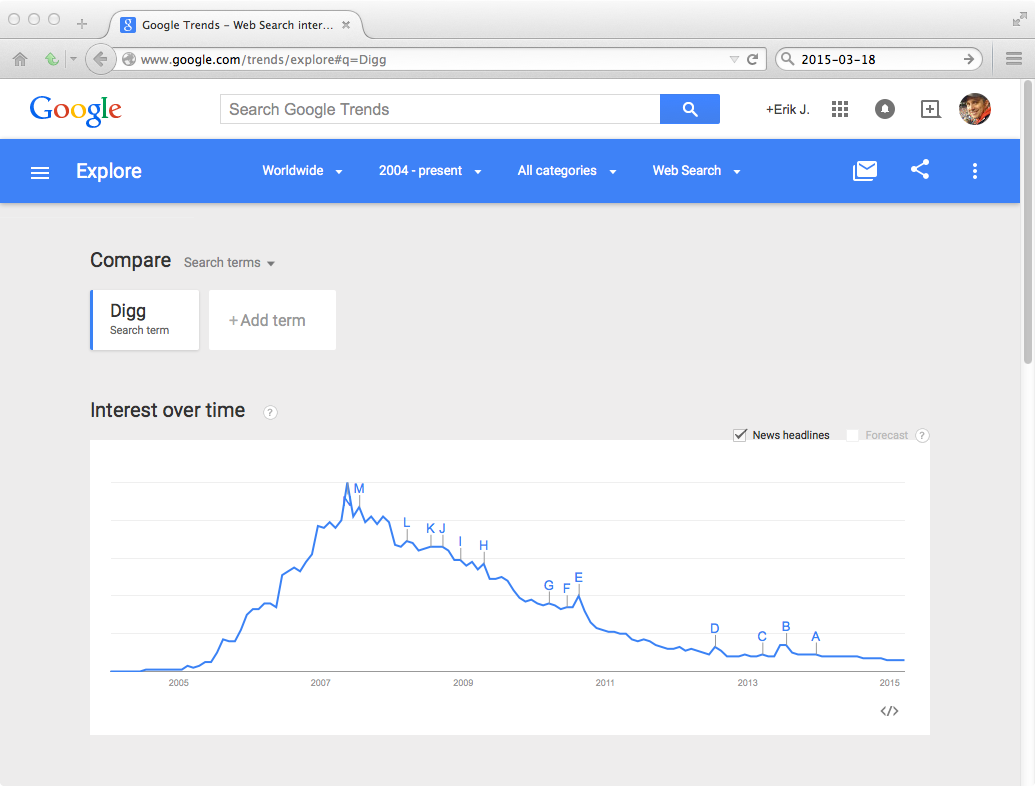
Digg (peak = May 2007, rotten = May 2009)
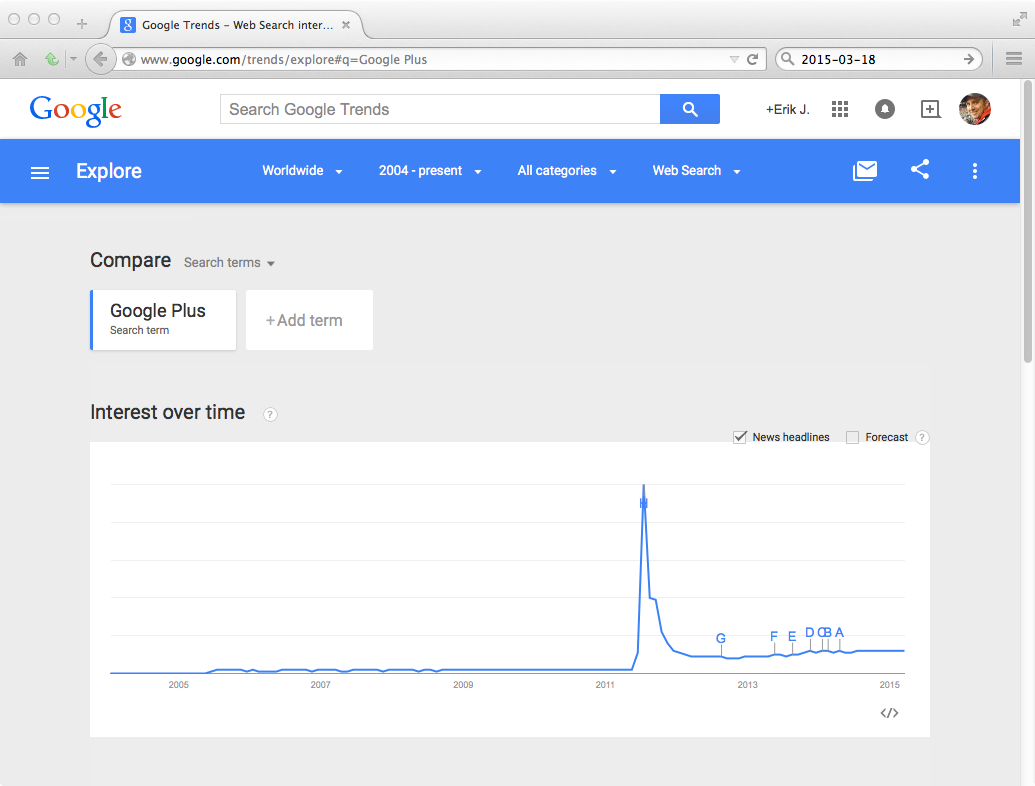
Google Plus (peak = July 2011, rotten = August 2011)
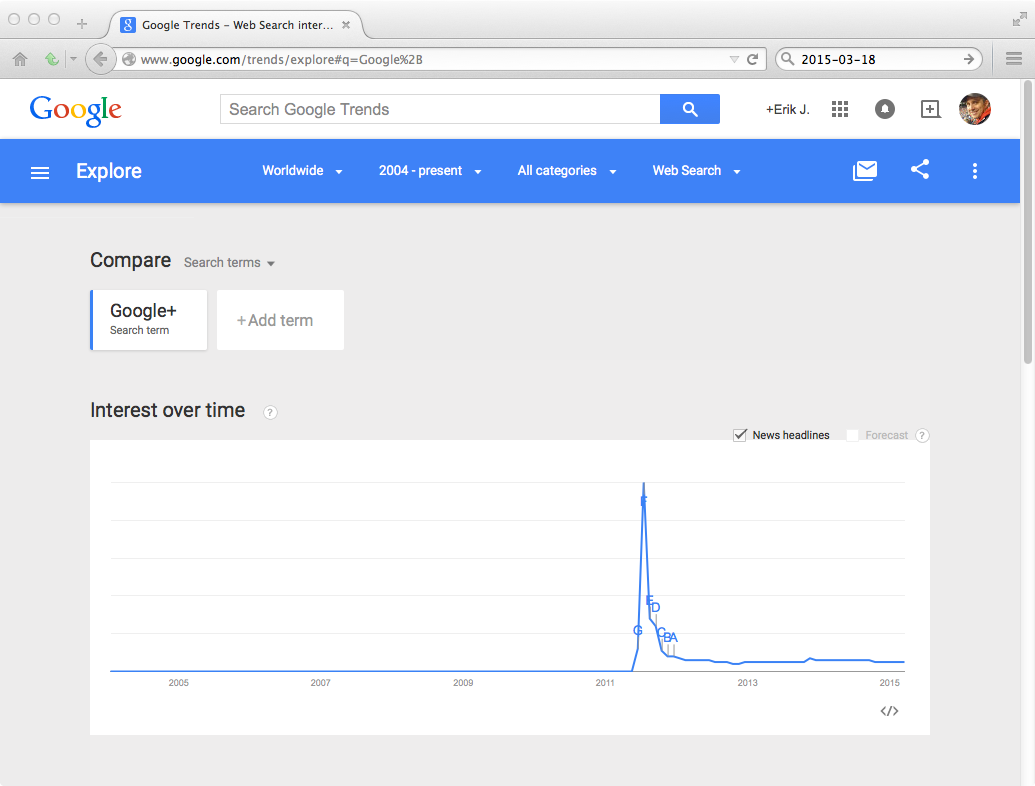
Google+ (peak = July 2011, rotten = August 2011)
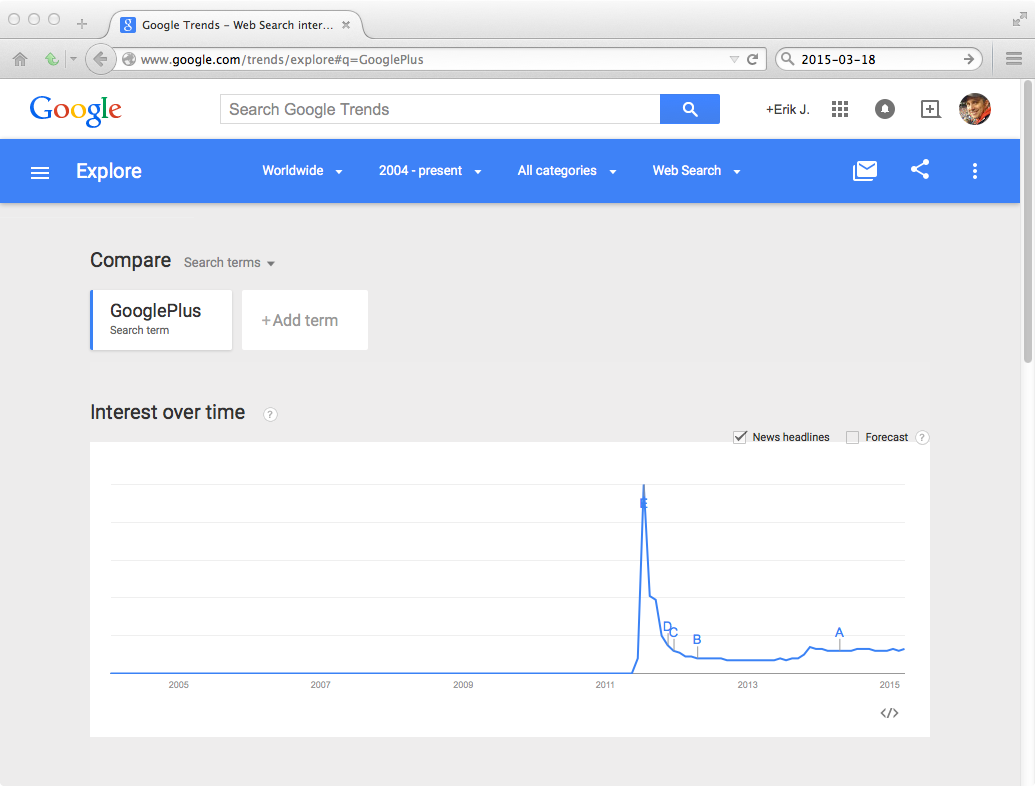
GooglePlus (peak = July 2011, rotten = August 2011)
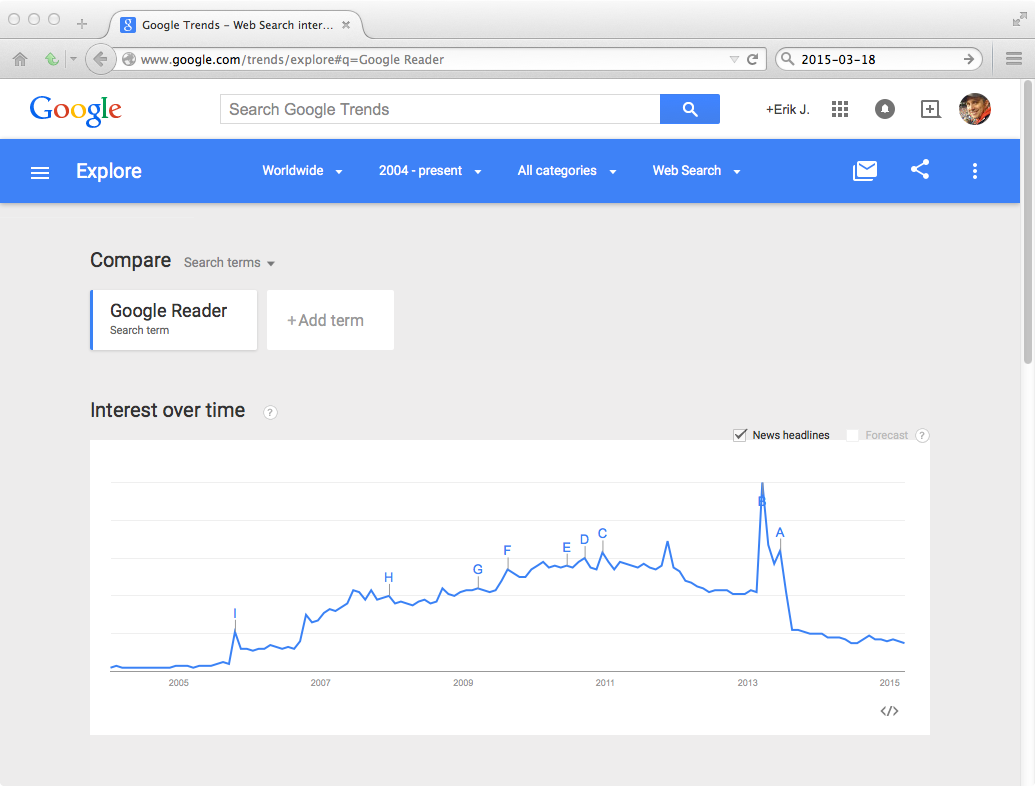
Google Reader (peak = December 2010, rotten = August 2013)
Google Trends: Relative Interest Rankings For The Top 15 Social Networks
Since Google Trends only allows you to compare five terms at a time, I had to run multiple searches in order to arrive at the above individual rankings. But when you compare the top five online empires on the same graph, Facebook clearly dominates. The same is true of other groupings. Just as #1 Facebook dominates #2 YouTube and #3 Google, #4 Yahoo dominates #5 MySpace and #6 Twitter, and #7 blog(ging) dominates #8 AOL and #9 Tumblr.
I ran searches in groups of 3 of the top 15 online empires:
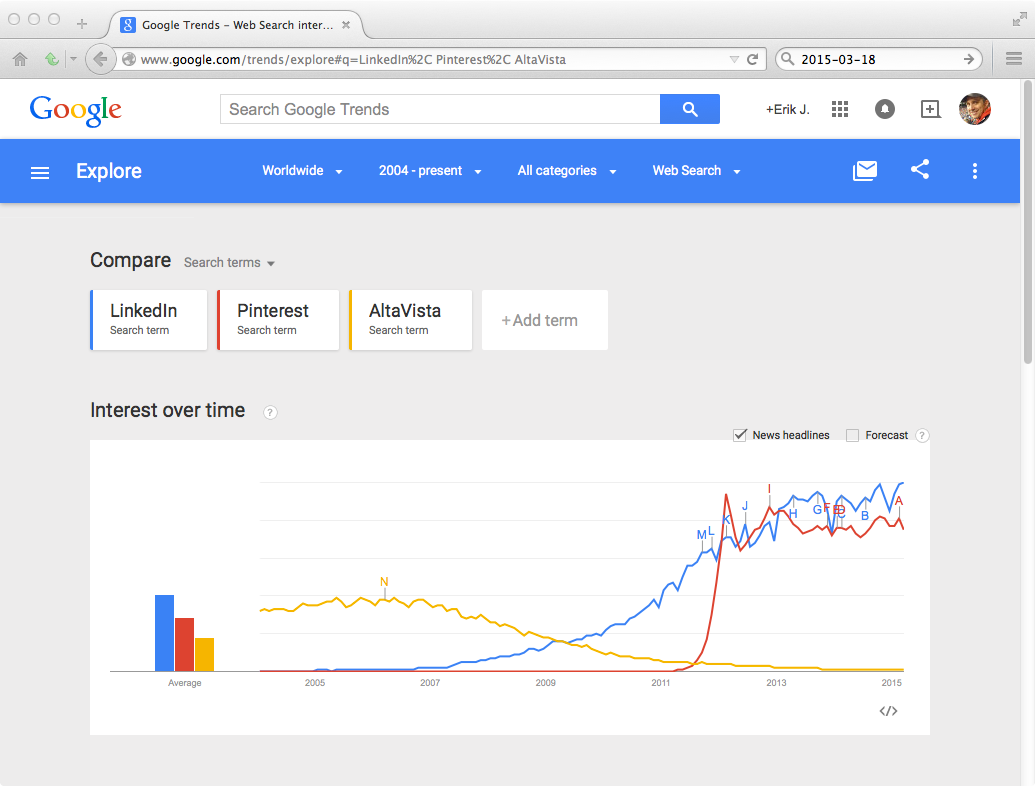
LinkedIn, Pinterest, AltaVista
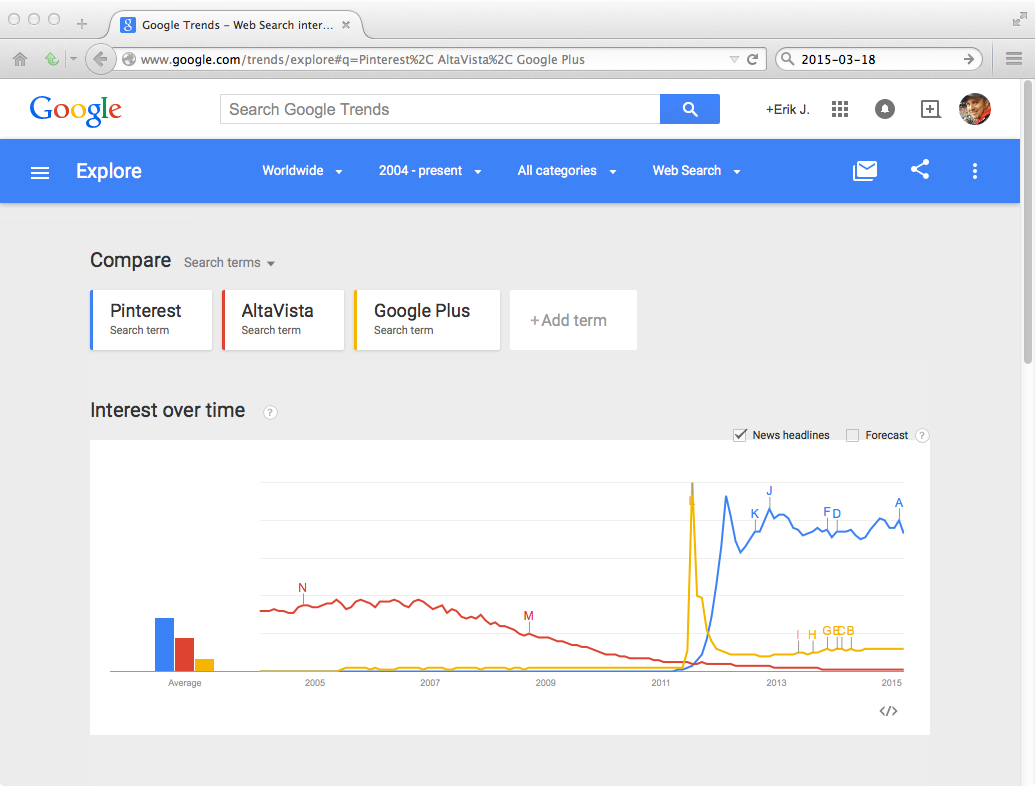
Pinterest, AltaVista, Google Plus
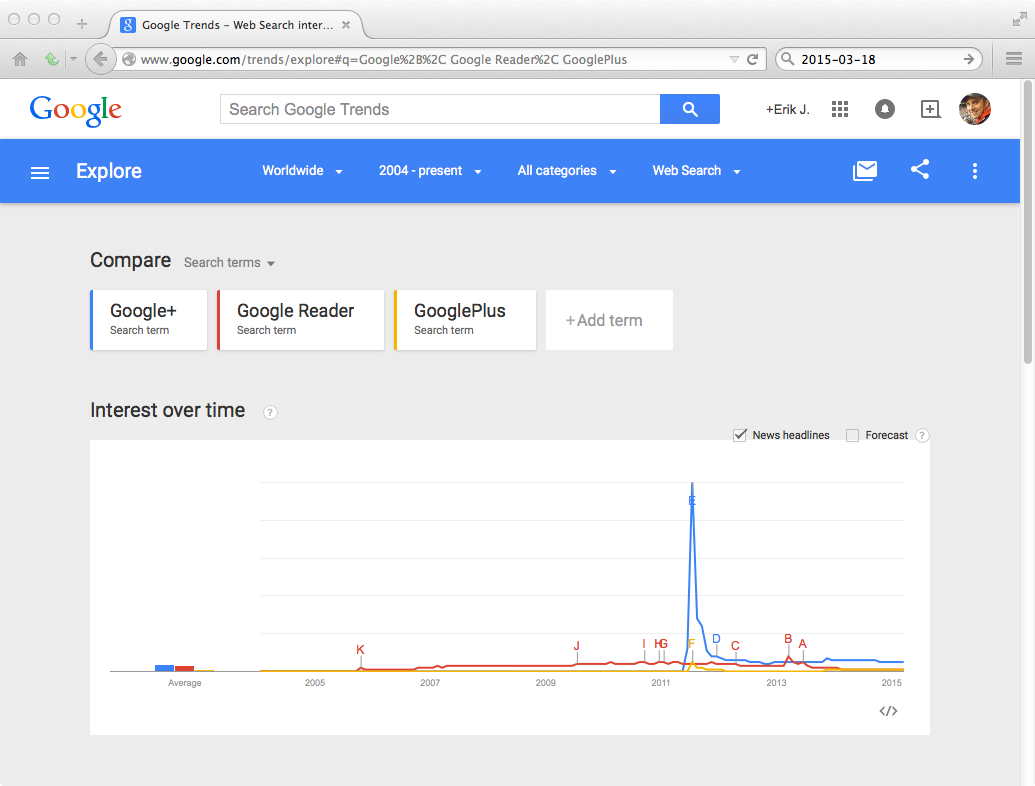
Google+, Google Reader, GooglePlus
Why Do I Care About This Stuff?
Fair question.
I’ve been on the Internet since 1984, had my 15 minutes of fame in 1994, worked for Internet companies from 1995-2001, then launched my law firm, Clocktower. The Internet matters to me both because it is an effective marketing channel and because it is where many of Clocktower’s cool clients live. So I like to keep track of Internet trends because Internet and because Clocktower.
As for my business, patents and trademarks are trending down:
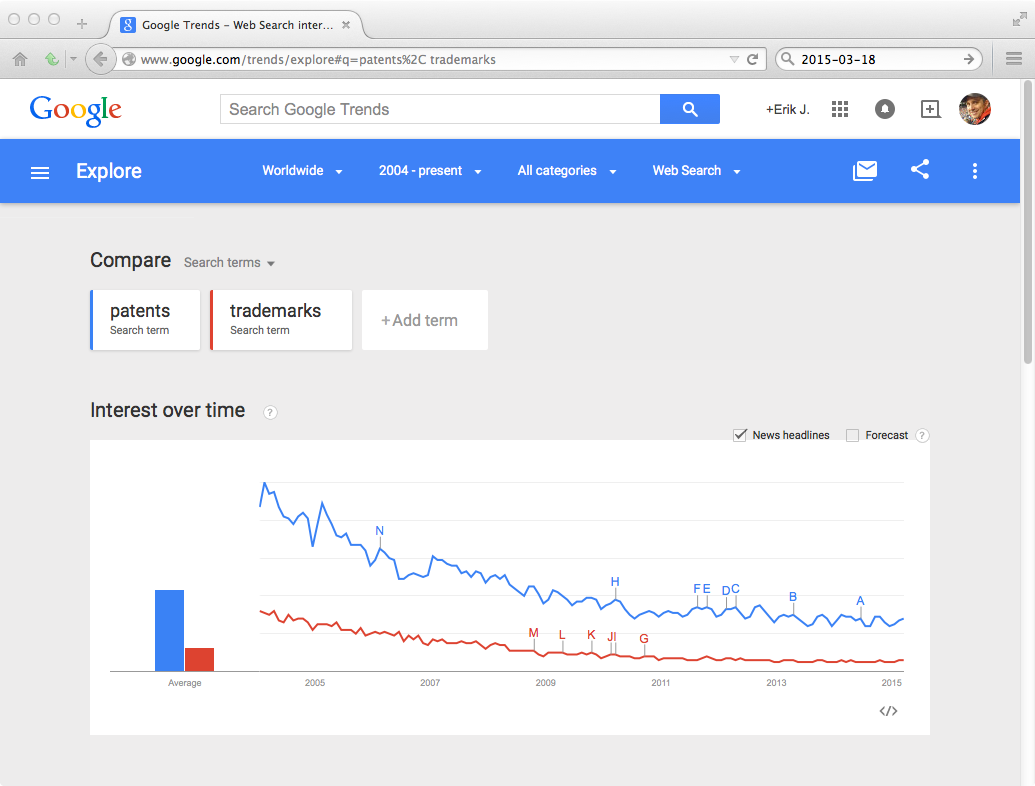
But public companies and the Fortune 1000 are also trending down:
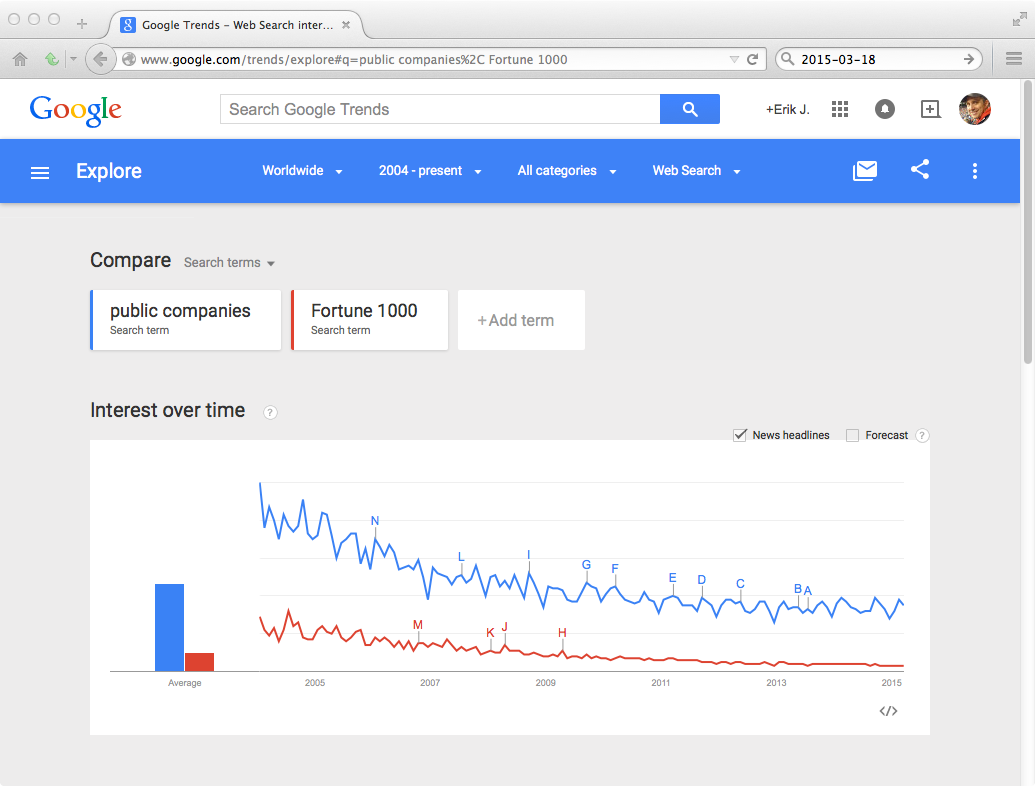
Fortunately, startups are trending up:
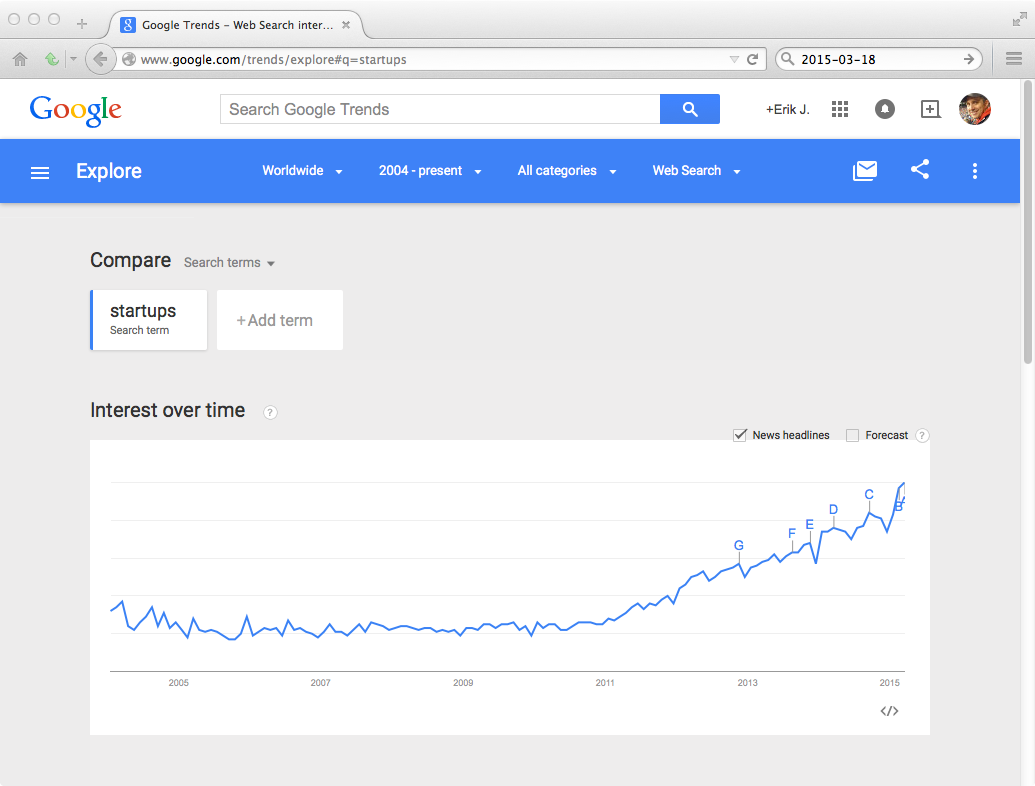
So Clocktower should be OK for the next 17 years or so.
Similarly, even if Facebook is in decline, it is so huge that it should dominate social networking for the next 17 years or so.
Summary
The worst business book from the 1990s, IMHO, is “The Innovator’s Dilemma” (1997). In that book, the author manages to turn an obvious and simple proposition (namely, that companies must compete with themselves before their competitors do) into a book by massaging data to fit the author’s pre-determined conclusion. In doing so, the author falls into one of the same traps for the unwary that entrepreneurs stumble (or, more correctly, eagerly leap) into: namely, believing your own press releases. Just like day traders in the 1990s had delusions of grandeur, entrepreneurs ridding a wave (or living in a bubble – pick your analogy) fall prey to fooling themselves.
My friend Peter, a serial entrepreneur, tells the story of advising an early-stage startup in the early 2000s (whatever that decade is called). While trying to raise a B round, the founders told Peter of their product success, (dubious) EBITDA positive, and projections for the future. When they finished their pitch, Peter asked them one question: “How many hours are employees working, on average, per week?” The founder enthusiastically answers, “Oh 70-80 hours per week easy! We live our work, we work when we’re home!” Peter calmly replied, “Well, the reality is that you have no business. Working 70+ hours/week is neither scaleable nor sustainable. Furthermore, correctly adjusted for a 40-hour work week, you are losing money, have no likelihood of ever turning a profit, and are trending down. Good luck.”
So the lesson for social networks of the 2010s (whatever this decade is called) is simple: don’t believe your own press releases. If you want to build to flip, then build to flip, but be prepared to see your hard work wither on the vine when you do. Otherwise, build to last, but know that few companies (much less social networks) end up being living companies.
As for the social networks listed above, except for behemoth Facebook and tortoise-like LinkedIn, it’s been nice to know you.
Related Posts
- Twitter Bug Makes Tweet Archives Unreliable For eDiscovery (2014-11-17)
Tweets from 2010 and earlier suffer from URL redirection problem. - How To Regain Your Social Networking Virginity (2014-04-01)
Simplifying your life on LinkedIn, Facebook, Twitter, Google+, and other social networks. - Top 10 Questions To Ask Before Your Company Spends Money On Social Media (2010-09-12)
Social networking is not magic. - Drawing That Explains Contact Syncing (2010-02-04)
Email is social networking glue. - How To Twittersquat The Top 100 Brands (2009-01-08)
A call for the creation of the Uniform Username Dispute Resolution Policy. - Drawing That Explains Social Networking (2008-11-03)
How to visualize social networking. - Fire Your Website, Hire A Weblog (2003-09-01)
Don’t start a weblog. Replace your website with a weblog. In November 2002, I started experimenting with weblog software. Three months into the experiment, I had converted my existing website into a weblog powered by Radio Userland Software. After only two months, I switched to the much more capable Movable Type software. In this article, I discuss what I did, how I did it, and why some law firms are catching weblog fever. - Business Is A Conversation (Or Clueful Lawyers) (2000-10-01)
The business of law is a conversation. Are you conversing?
Erik J. Heels is a patent and trademark lawyer for Boston startups, Red Sox fan, MIT engineer, and musician. He blogs about technology, law, baseball, and rock ‘n’ roll at erikjheels.com.
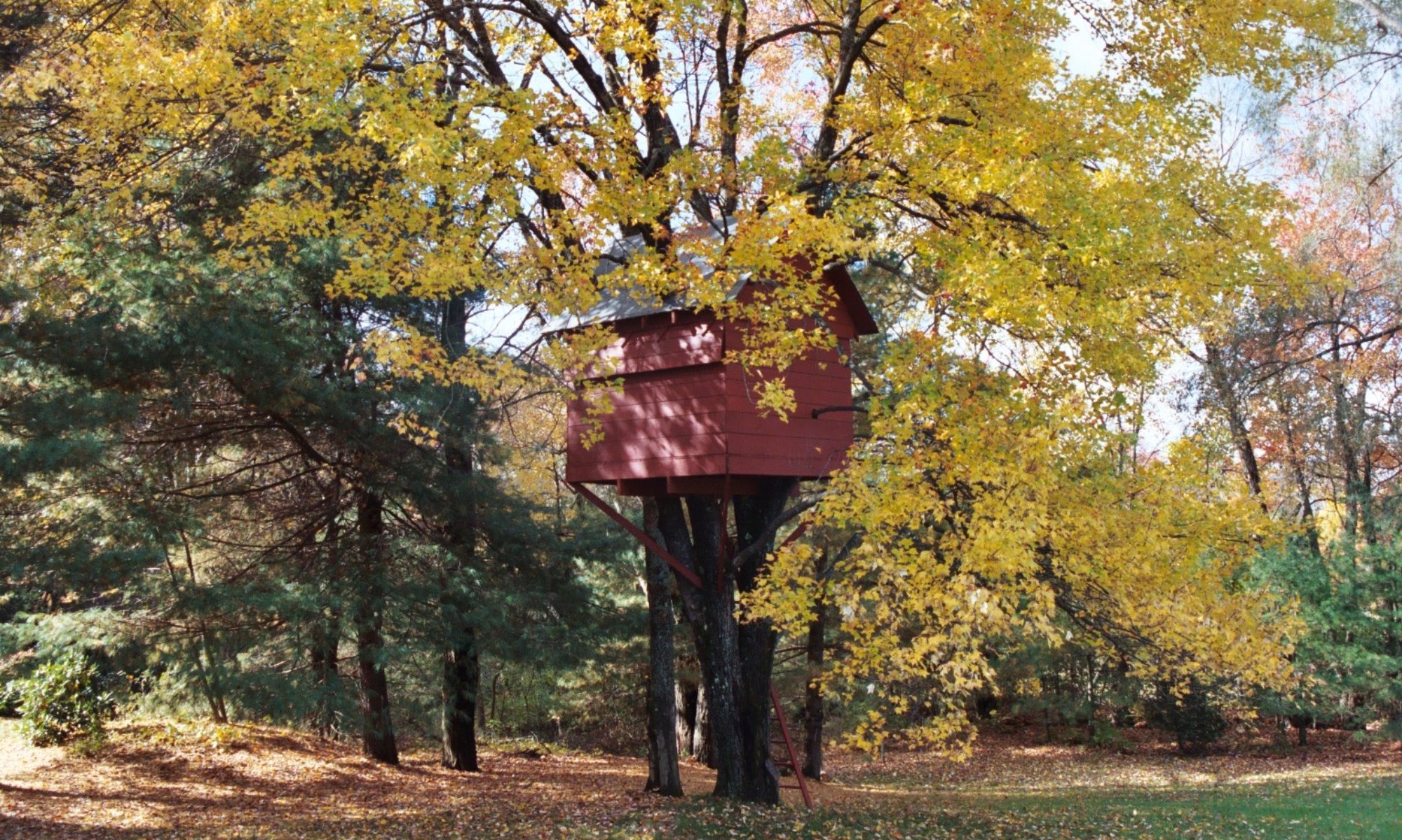

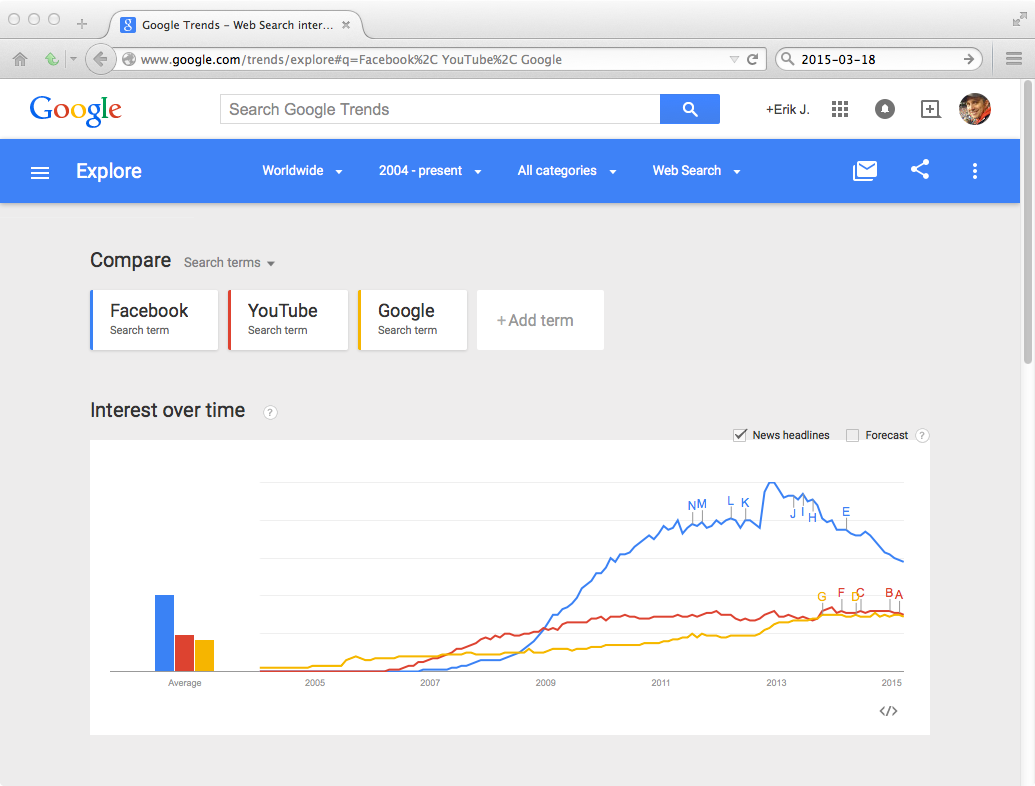
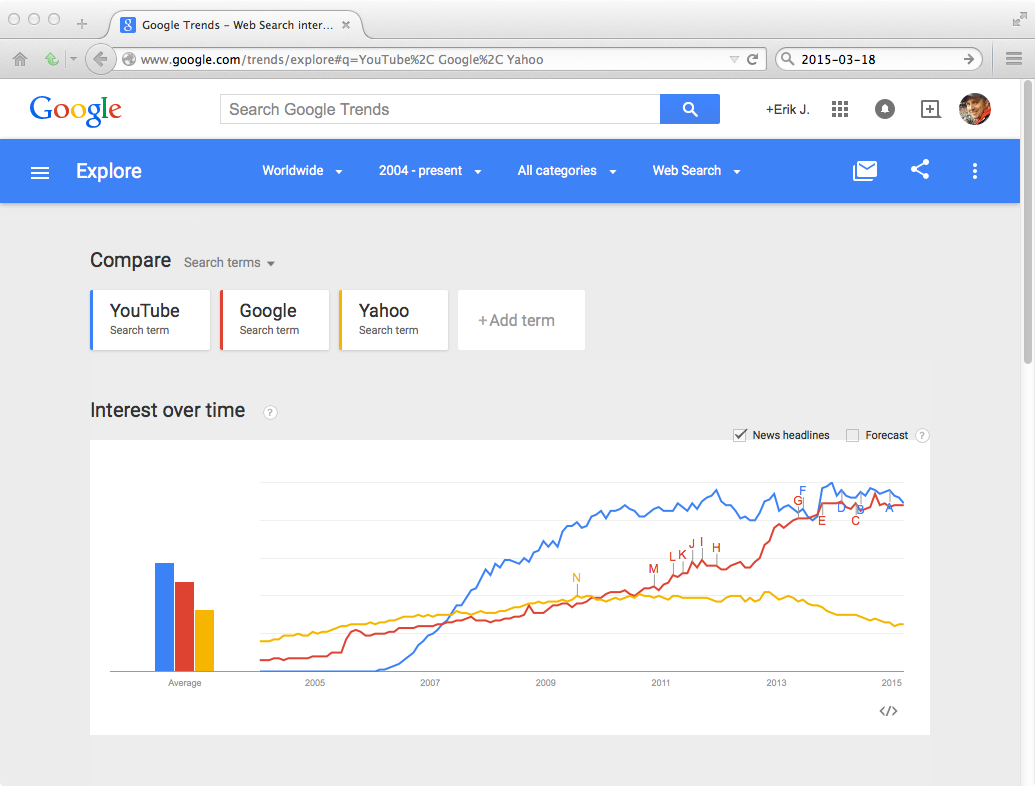
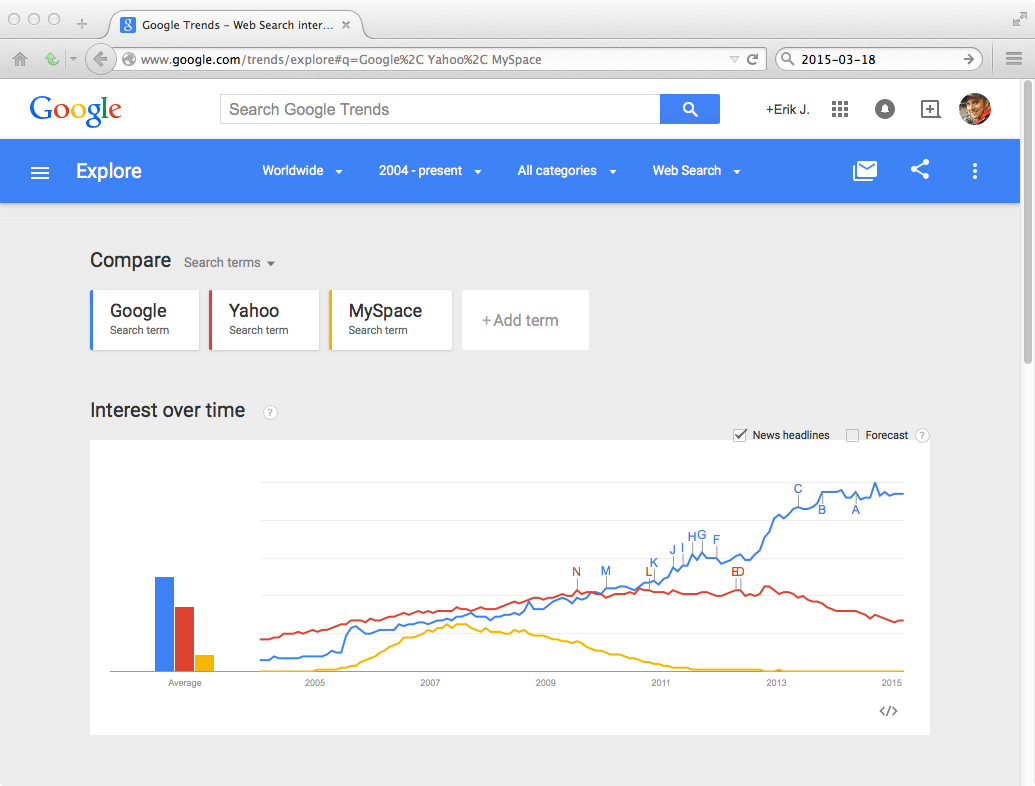
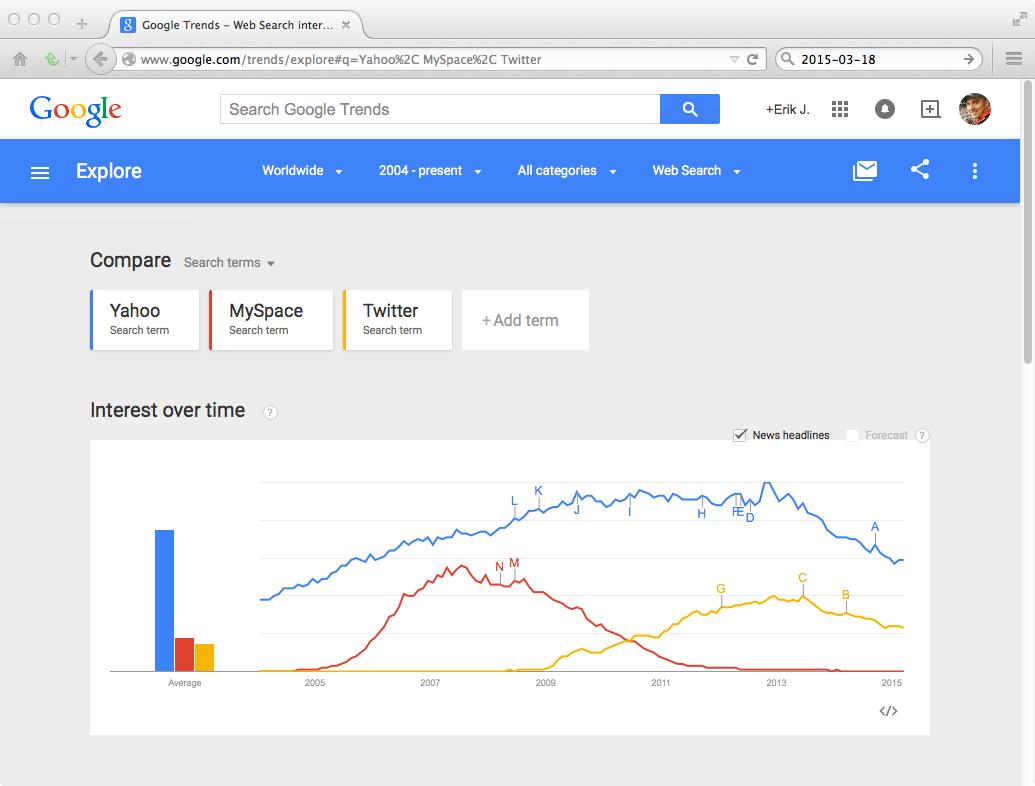
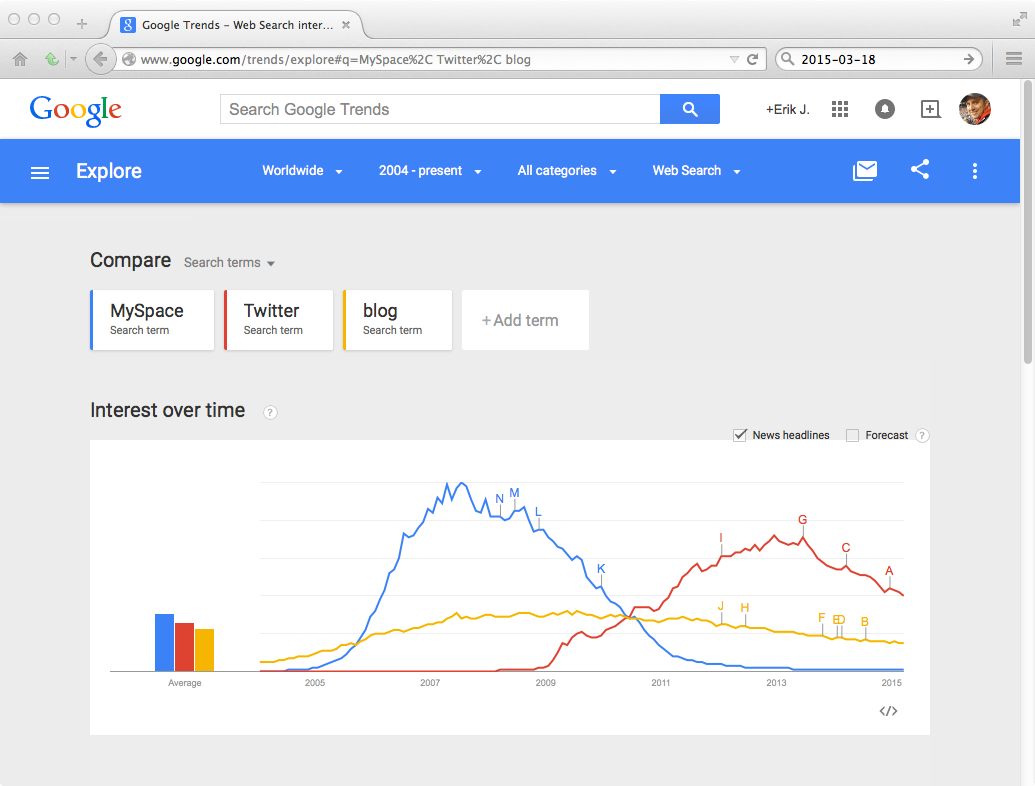
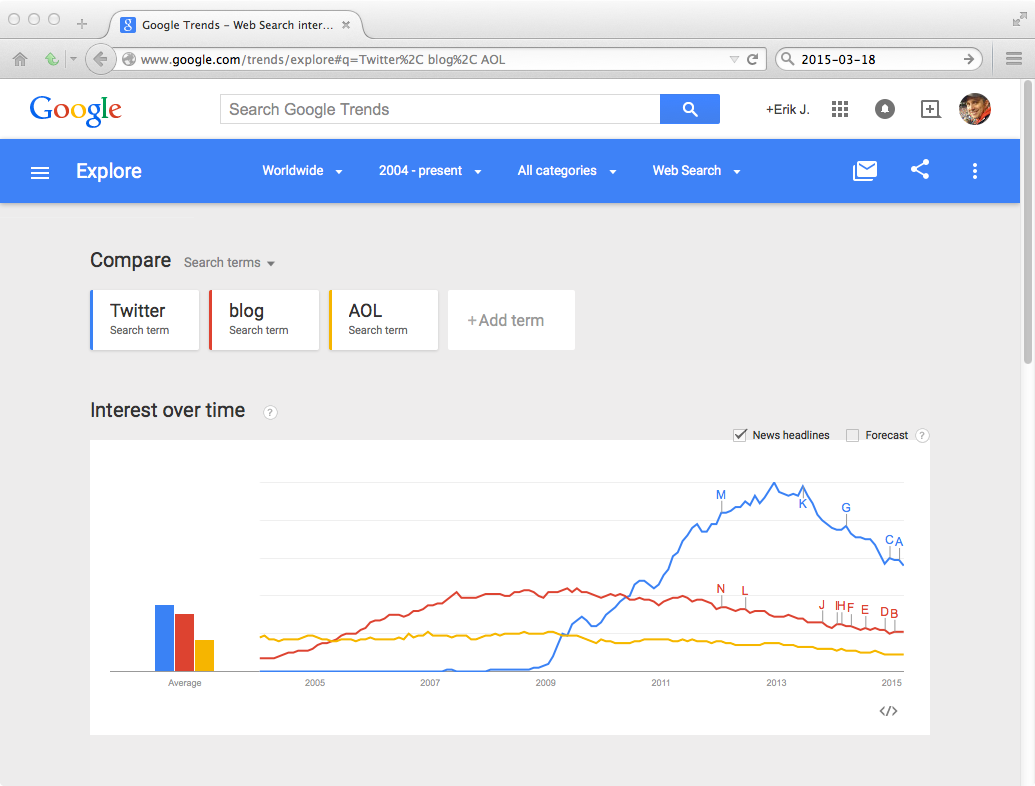
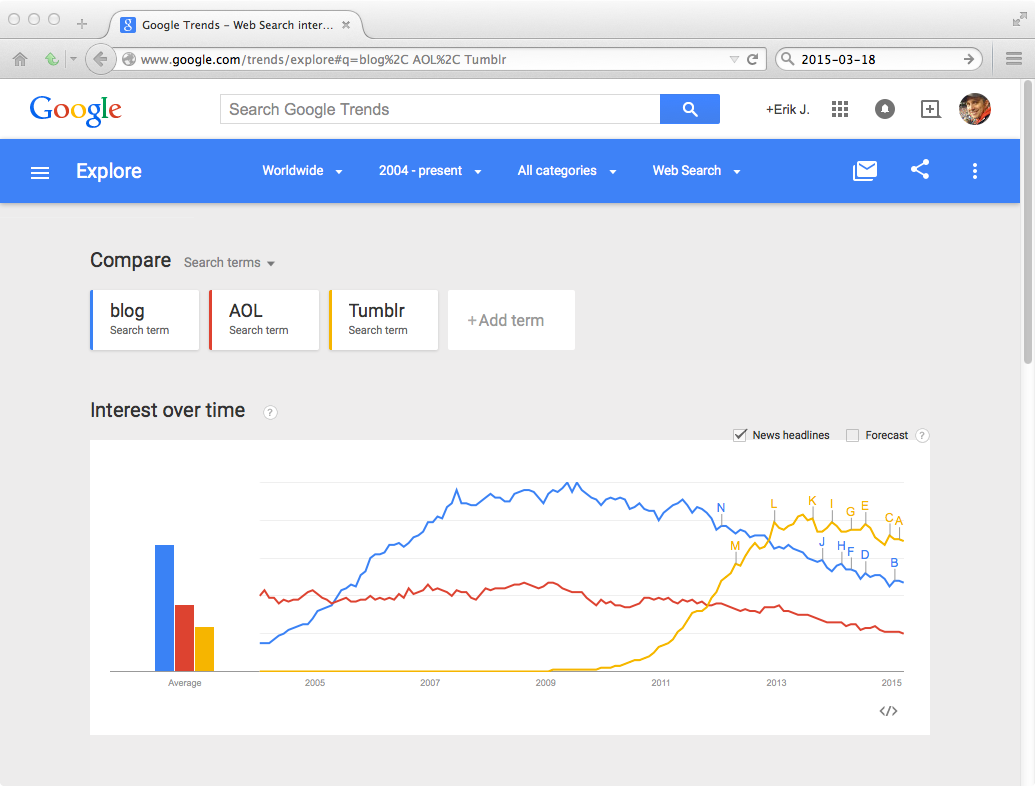
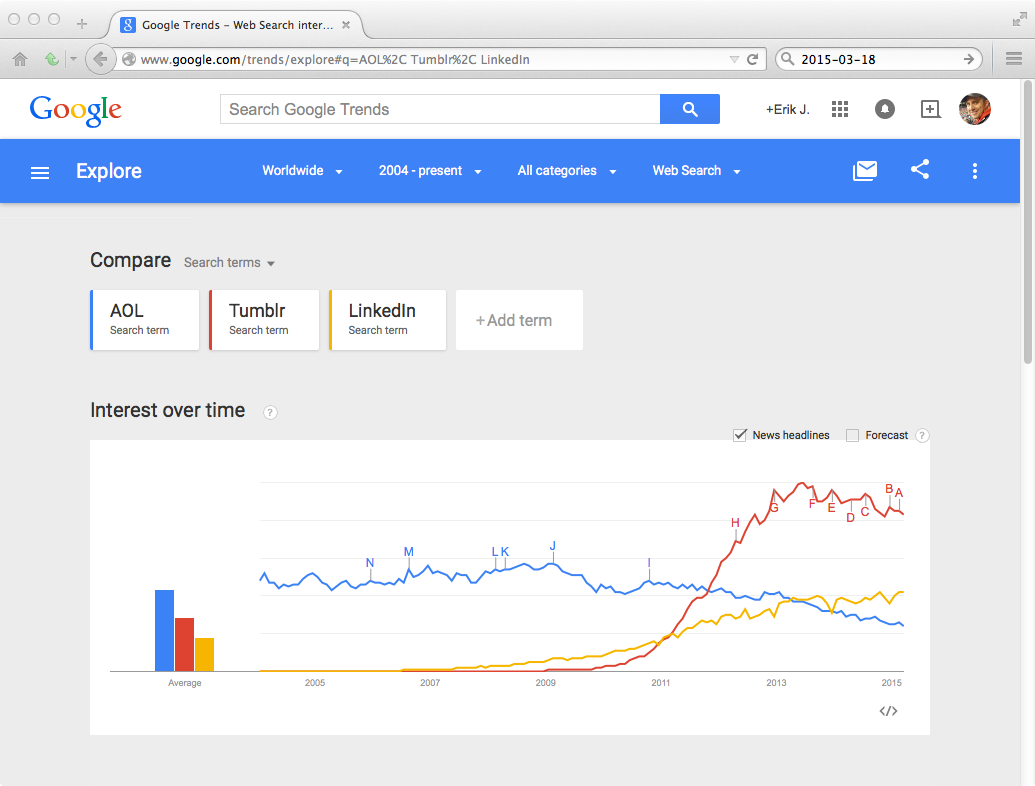
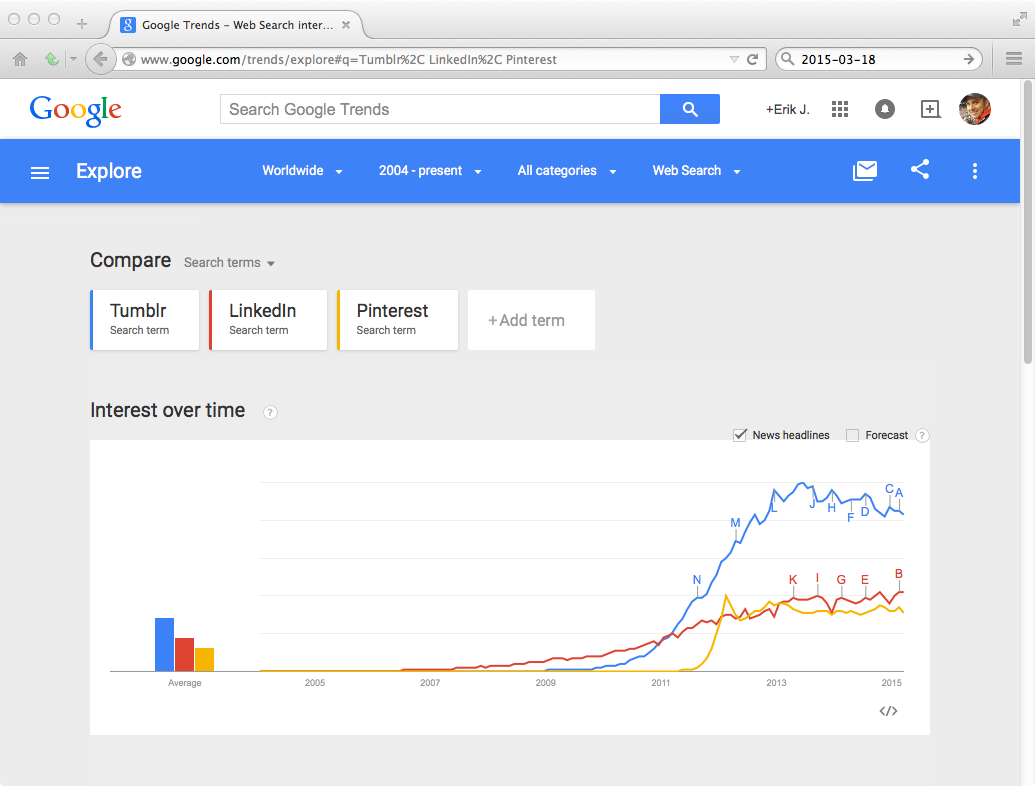
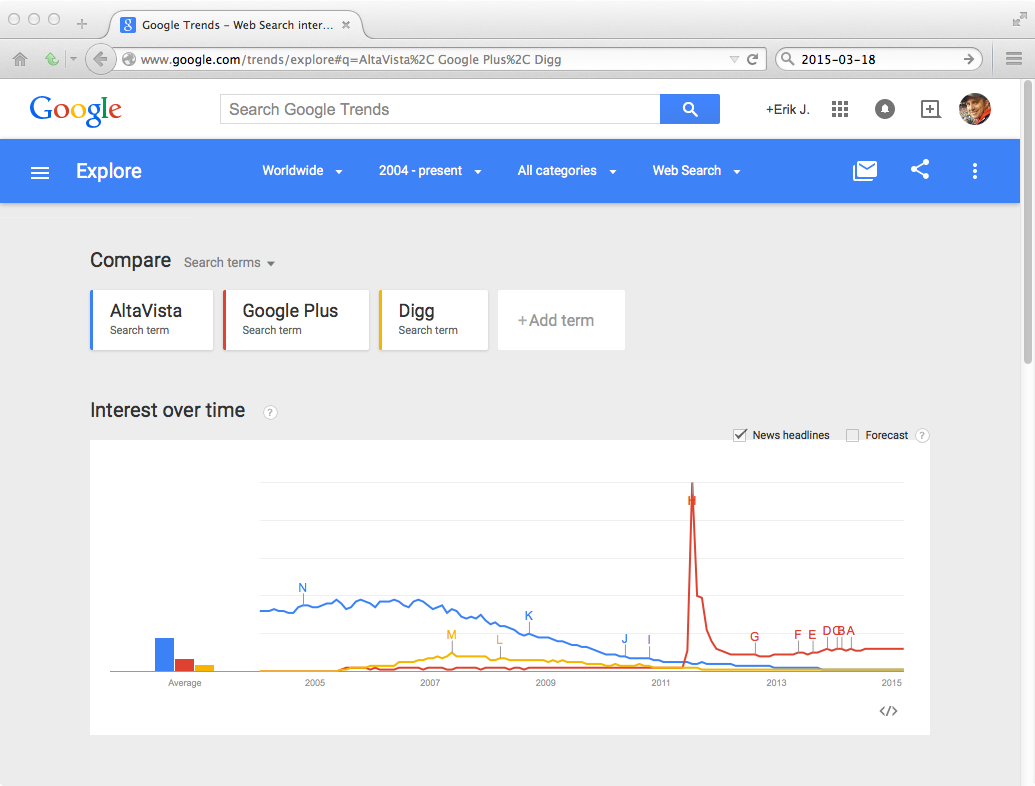
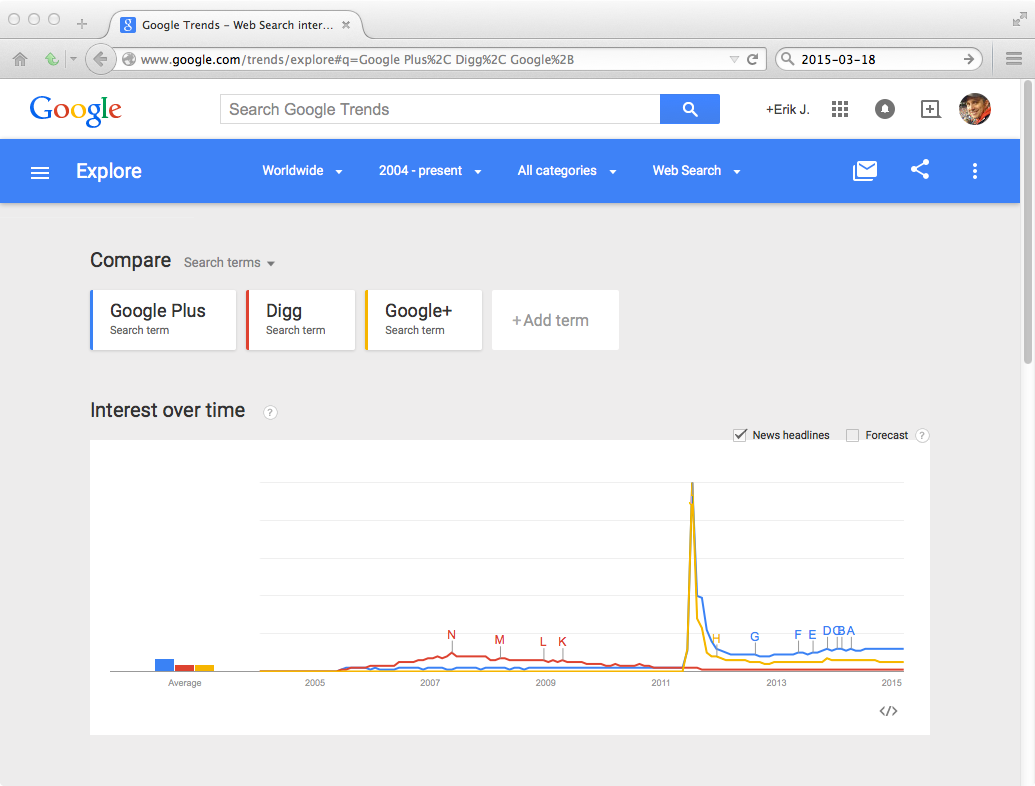
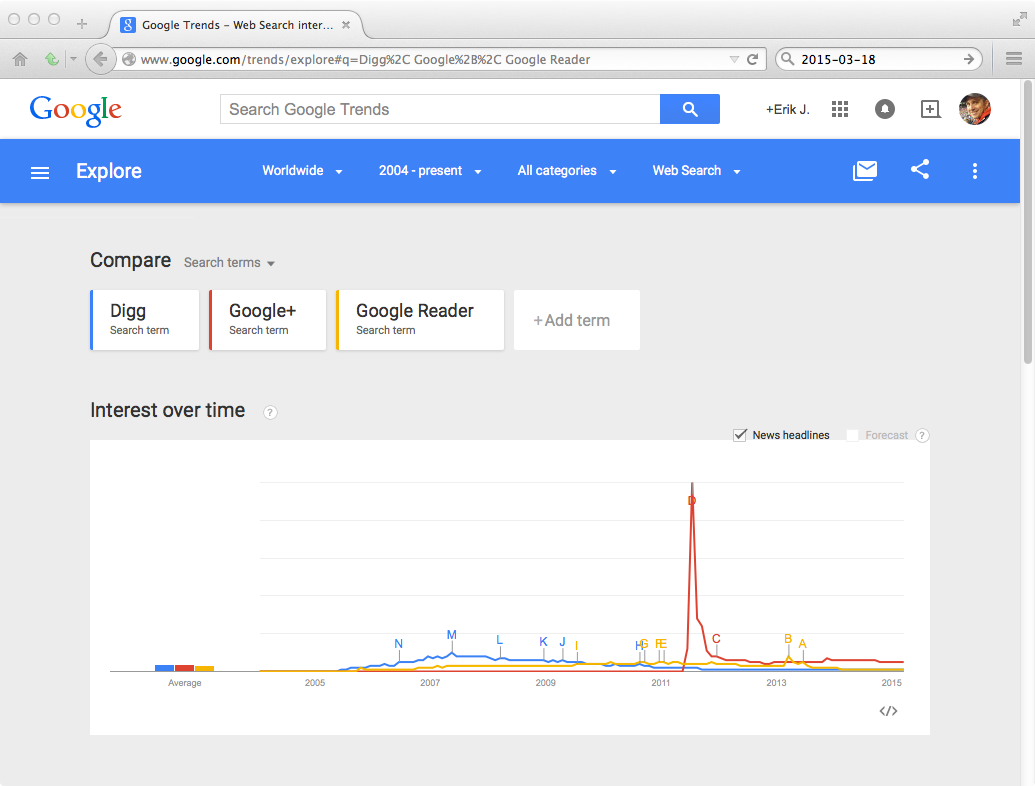

* Google+ As We Knew It Is Dead, But Google Is Still a Social Network (2015-03-03)
http://www.wired.com/2015/03/google-knew-dead-google-still-social-network/